IB Bio Exam (2023)!
5.0(1)
5.0(1)
Card Sorting
1/121
Earn XP
Description and Tags
questions and answers from our past tests. note: unit 4, questions 11-18 I couldn't find the answers for so they aren't on here. sorry. plus, questions from the 2.1, 2.3 quiz too. also sorry.
Study Analytics
Name | Mastery | Learn | Test | Matching | Spaced |
|---|
No study sessions yet.
122 Terms
1
New cards
Which process(es) occur(s) by osmosis?
I. Uptake of water by cells in the wall of the intestine
II. Loss of water from a plant cell in a hypertonic environment
III. Evaporation of water from sweat on the skin surface
I. Uptake of water by cells in the wall of the intestine
II. Loss of water from a plant cell in a hypertonic environment
III. Evaporation of water from sweat on the skin surface
I. Uptake of water by cells in the wall of the intestine
II. Loss of water from a plant cell in a hypertonic environment
II. Loss of water from a plant cell in a hypertonic environment
2
New cards
Where do hydrogen bonds form?
Between the slight positive charge of hydrogen and slight negative charge of oxygen in different water molecules
3
New cards
Which is an essential feature of the Davson–Danielli model of membrane structure?
A layer of lipid sandwiched between two layers of protein
4
New cards
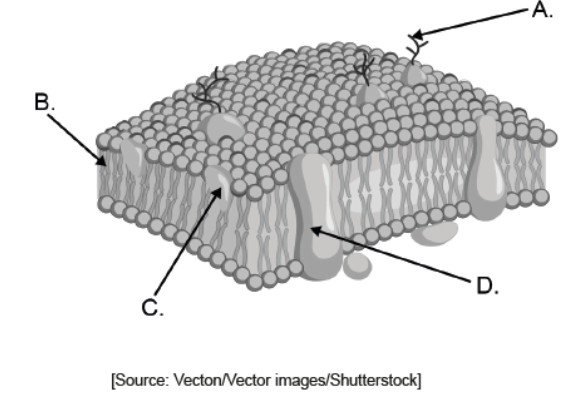
What part of the plasma membrane is fluid, allowing the movement of proteins in accordance with the fluid mosaic model?
B
5
New cards

Apparatus was set up as shown to collect data. The graph shows the results after 47 minutes of data collection.
What causes the rates to differ?
I. Different concentration gradients at the start
II. Diffusion of sugar is initially greater in Y than in X
III. The systems are reaching equilibrium over time
What causes the rates to differ?
I. Different concentration gradients at the start
II. Diffusion of sugar is initially greater in Y than in X
III. The systems are reaching equilibrium over time
I and III only
6
New cards
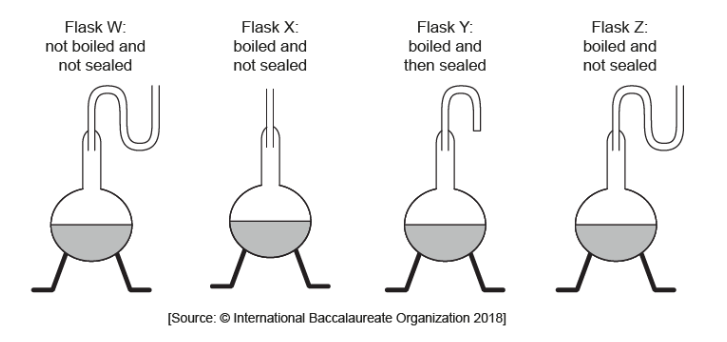
In a copy of Louis Pasteur’s famous experiment, broth was put into flasks as shown in the diagrams.
What results would be expected with no spontaneous generation of life?
What results would be expected with no spontaneous generation of life?
Decomposition of broth by microbes occurred only in Flasks W and X.
7
New cards
What feature of both striated muscle and aseptate fungal hyphae is different from typical cell structure?
They have multiple nuclei within a structural unit.
8
New cards
Which molecule regulates the fluidity of cell membranes?
Cholesterol
9
New cards
Which features of phospholipids give them their amphipathic properties?
Hydrophilic phosphate groups and hydrophobic fatty acids
10
New cards
How is facilitated diffusion in axons similar to active transport?
They are both carried out by proteins embedded in the axon membrane.
11
New cards
How do both mitochondria and chloroplasts provide evidence for the endosymbiotic theory?
They have double membranes.
12
New cards
What is the term for the attraction of water molecules to other water molecules?
Cohesion
13
New cards
The Davson–Danielli model of membrane structure proposed that membranes were composed of a phospholipid bilayer that lies between two layers of globular proteins.
What evidence supported this model?
What evidence supported this model?
An electron micrograph that showed two dark lines with a lighter band in between
14
New cards
A human organ is being prepared for transplant. In what type of solution must it be bathed?
A solution with the same osmolarity as the organ tissue
15
New cards
Which statement applies to cholesterol?
It impacts membrane fluidity.
16
New cards
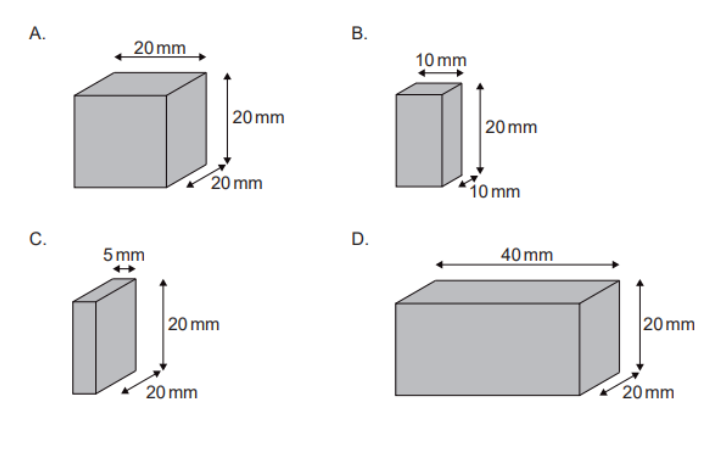
The diagrams represent cells with the same concentration of dissolved substances in their cytoplasm. If all the cells were placed in the same hypertonic sucrose solution, which cell would show the greatest rate of change in the concentration of its cytoplasm?
C
17
New cards
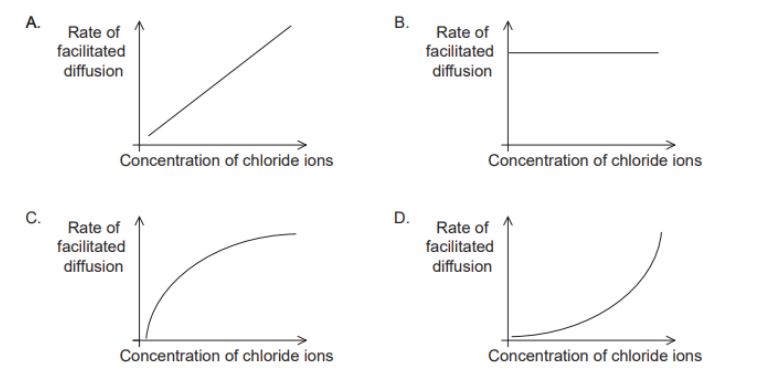
Which graph best represents the relationship between the concentration of chloride ions in the external environment of a cell and the rate at which the chloride ions move by facilitated diffusion into the cytoplasm of the cell?
C
18
New cards
What is a property of water?
Water molecules are highly cohesive which is important for transport in xylem.
19
New cards

The images show samples of red blood cells that were placed in different concentrations of salt solutions.
Which process explains the observations shown in the images?
Which process explains the observations shown in the images?
Osmosis
20
New cards
Three cell types are shown in the micrographs.
What feature distinguishes striated muscle fibres from the three cell types shown in the images?
What feature distinguishes striated muscle fibres from the three cell types shown in the images?
Multinucleate structure
21
New cards
The giant alga *Acetabularia* has a feature that suggests it is an exception to the cell theory. What feature is this?
It lacks subdivision into separate cells.
22
New cards
What is a role of cholesterol in animal cells?
It controls membrane fluidity.
23
New cards
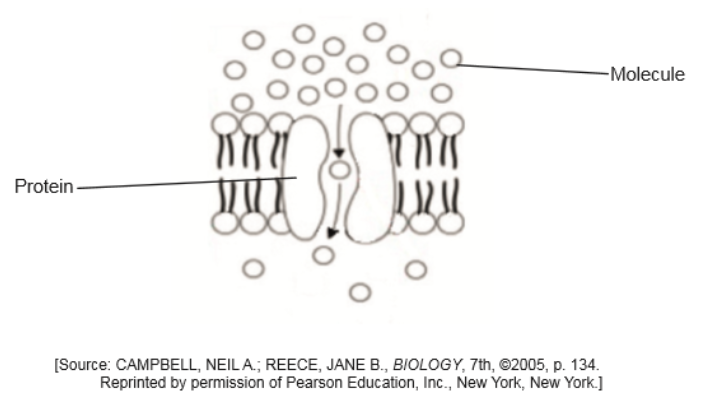
The diagram is a model of one type of movement across a membrane.
What is this type of movement?
What is this type of movement?
Facilitated diffusion
24
New cards
The graph shows enzyme activity plotted against temperature.
What is the reason for the drop in enzyme activity above 40 °C?
What is the reason for the drop in enzyme activity above 40 °C?
Changes to the conformation of the enzyme
25
New cards
Cell metabolism involves anabolic and catabolic reactions. Which process directly involves anabolism?
Production of intracellular enzymes
26
New cards
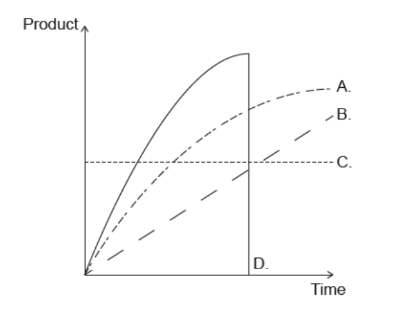
Which curve shows the concentration of product during the course of an enzyme-catalysed reaction?
A
27
New cards
Lipids are more efficient energy stores than carbohydrates. What is a reason for this?
Lipids release more energy per gram than carbohydrates.
28
New cards
People who suffer from night blindness cannot see well at night because their retinal cells produce an abnormal form of a protein pigment. Which protein is this?
Rhodopsin
29
New cards
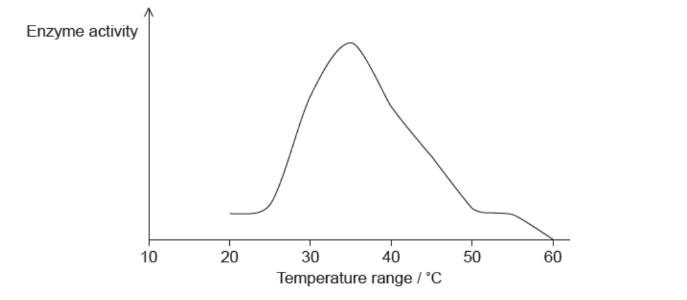
The graph shows the activity of an enzyme at various temperatures. The pH of the experiment was kept constant at pH 8.
Based on the data, what would the result be if the experiment was repeated at pH 9?
Based on the data, what would the result be if the experiment was repeated at pH 9?
There is not enough information to make a reliable prediction.
30
New cards
The production of oxalic acid can be prevented if the person drinks ethanol, a competitive inhibitor of the enzyme alcohol dehydrogenase I. Which statement explains the mode of action of ethanol on the reaction?
It occupies the active site of alcohol dehydrogenase I, preventing ethylene glycol from binding.
31
New cards
Cell metabolism involves anabolic and catabolic reactions. Which process directly involves anabolism?
Production of intracellular enzymes
32
New cards
Lactose can be removed from milk by passing the milk through a column of alginate beads to which immobilized lactase is bound. What is an advantage of immobilizing the enzyme?
It allows the product to be separated easily from the enzyme.
33
New cards
Which statement applies to enzymes?
Enzyme function depends on collisions between substrate and active sites.
34
New cards
Which statement applies to the tertiary structure of enzymes?
A change in the tertiary structure of an enzyme may result in a change in the structure of the active site.
35
New cards
Succinate dehydrogenase is an enzyme that catalyses the oxidation of succinic acid. If malonic acid is added to the mixture, the rate of reaction is reduced. An increase in succinic acid will increase the rate of reaction again. For this system, which term best describes malonic acid?
Competitive inhibitor
36
New cards
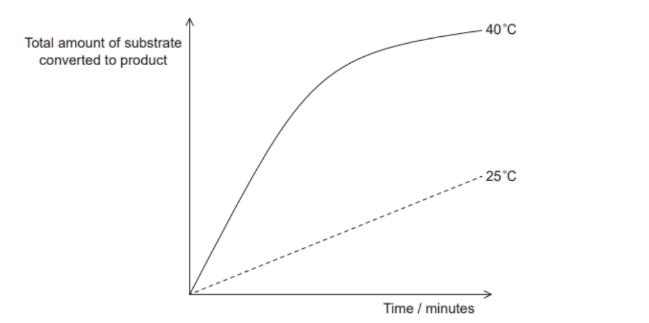
The graph shows the progress of the same enzyme-controlled reaction at two different temperatures.
Which statement is clearly supported by the data?
Which statement is clearly supported by the data?
The lower the temperature, the slower the rate of the reaction
37
New cards
Which organic molecules may contain the element sulphur?
Proteins
38
New cards
What is a proteome?
The entire set of proteins expressed by an organism at a certain time
39
New cards
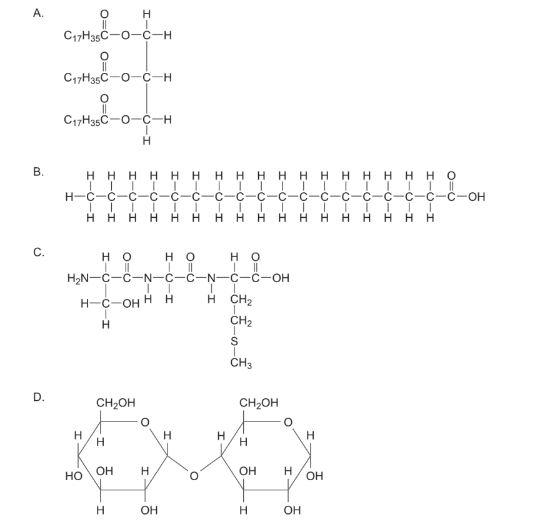
Which molecule could be hydrolysed into amino acids?
C
40
New cards

Water has a specific heat capacity of 4.2 J g K at room temperature, a latent heat of vaporization equal to 2257 J g , and a boiling point of 100 °C. What are the specific heat capacity, latent heat of vaporization and boiling point of methane?
A
41
New cards

Which protein is identified with its function?
A
42
New cards

The graph shows the effect of changing the substrate concentration on the early stages of an enzyme-catalysed reaction.
What can be interpreted about the rate of reaction from the graph?
What can be interpreted about the rate of reaction from the graph?
Rate of reaction increases non-linearly with increasing substrate concentration.
43
New cards
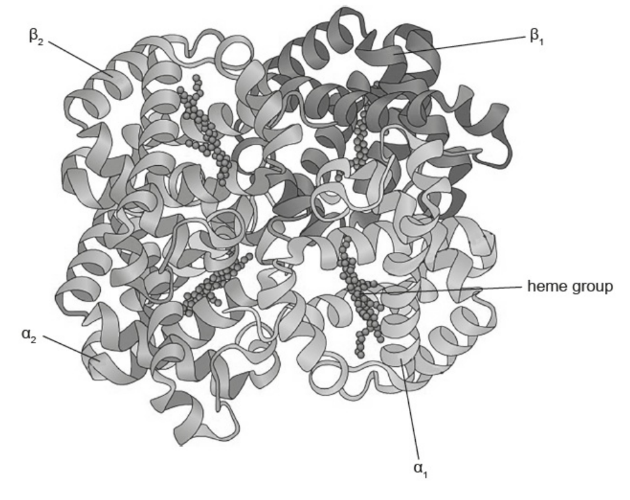
The image shows the structure of the protein hemoglobin
What level of protein structure bonds the α and β chains together?
What level of protein structure bonds the α and β chains together?
Quaternary
44
New cards
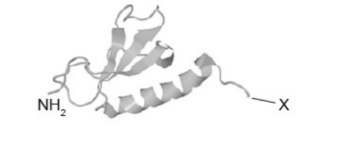
The diagram shows the structure of the protein CXCL12.
Which chemical group is found at X?
Which chemical group is found at X?
COOH
45
New cards
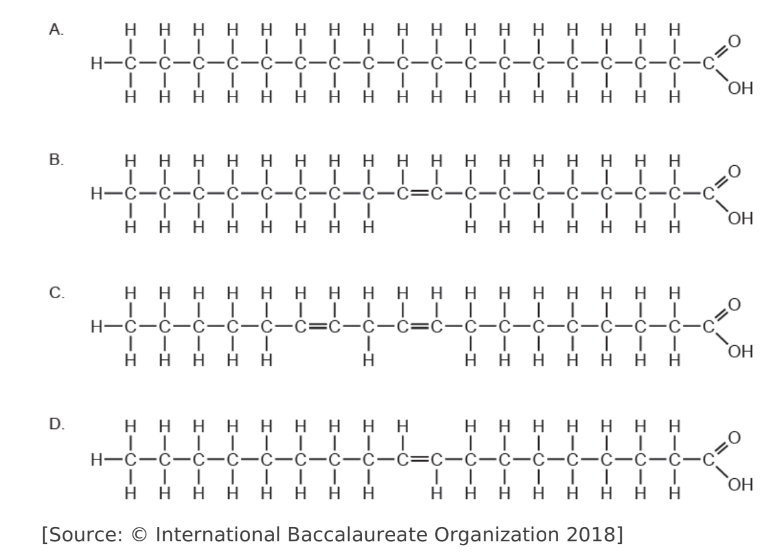
Which fatty acid would occur in a trans fat?
D
46
New cards
The Framingham heart study was an observational study that went on for 20 years. The following data were produced.
Which conclusion can be drawn, based on these data?
Which conclusion can be drawn, based on these data?
The more margarine consumed, the greater the incidence of coronary heart disease.
47
New cards
Three flasks were prepared for an analysis of the activity of amylase. At time zero, each of the substances indicated in the diagrams was added.
Which flask(s) could provide support for the hypothesis that heat denatures enzymes?
Which flask(s) could provide support for the hypothesis that heat denatures enzymes?
Flasks I and III after 15 minutes
48
New cards
DNA Helicase is an enzyme involved in DNA replication. In this process, DNA helicase breaks some bonds.
What bonds does DNA helicase break in the DNA strand?
What bonds does DNA helicase break in the DNA strand?
Hydrogen Bonds
49
New cards
What enzymes are used during the process of transferring DNA to bacterial cells?
Step 1: Endonuclease, Step 2: Ligase
50
New cards
Which of the following structures are **NOT** included in the structure of a nucleosome?
RNA
51
New cards
In what phase of the cell cycle, other than possibly M phase, would you find unreplicated chromosomes, assuming normal cell function?
G1
52
New cards
What structures do NOT contain nucleic acids in eukaryotic cells?
Golgi Apparatus
53
New cards
Where could you find the entire genome of an organism?
DNA present in nucleus, mitochondria and chloroplasts of plant cell
54
New cards
What processes/structures do viral particles share with living cells?
Genetic material
55
New cards
What enzyme could be found on both strands of the single sided strands of parent DNA?
DNA Polymerase
56
New cards
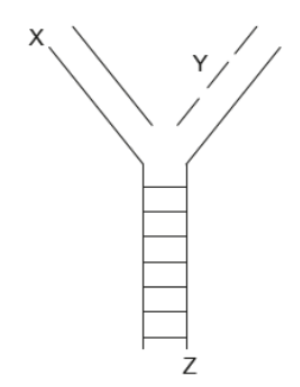
What direction does the enzyme which makes a new DNA strand work in?
5’ to 3’
57
New cards
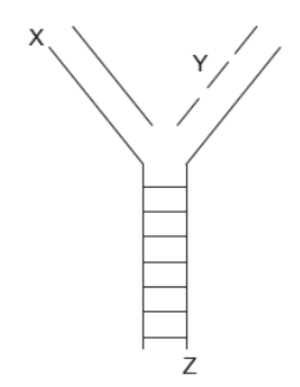
What is the structure labeled Y?
Lagging Strand
58
New cards
What features distinguish a prokaryotic chromosome from a eukaryotic chromosome?
Naked DNA and circular chromosomes
59
New cards
When does DNA replication occur?
S phase
60
New cards
What structures/features can be found within both eukaryotic and prokaryotic cells?
70S ribosomes
61
New cards
What contribution do Rosalind Franklin make to our understanding of DNA?
She collected data which indicated the helical shape of DNA
62
New cards
DNA and RNA share what?
Nitrogenous bases
63
New cards
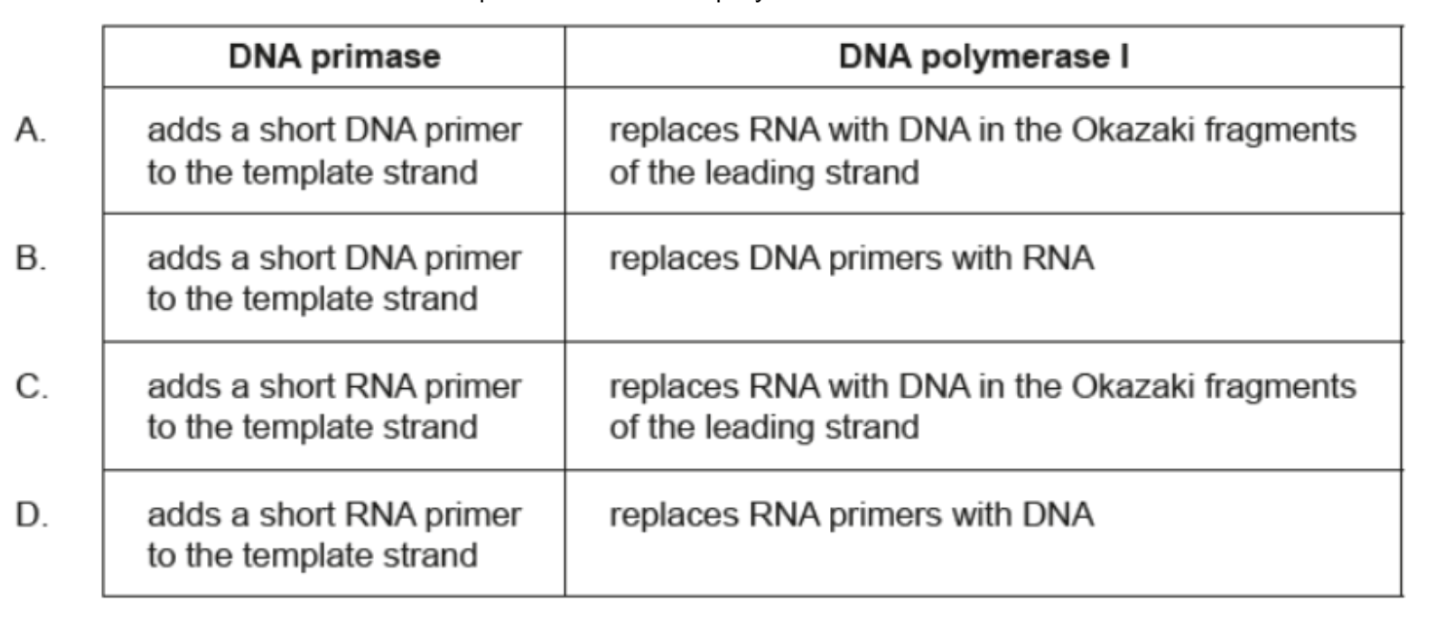
What are the functions of DNA primase and DNA polymerase I?
D
64
New cards
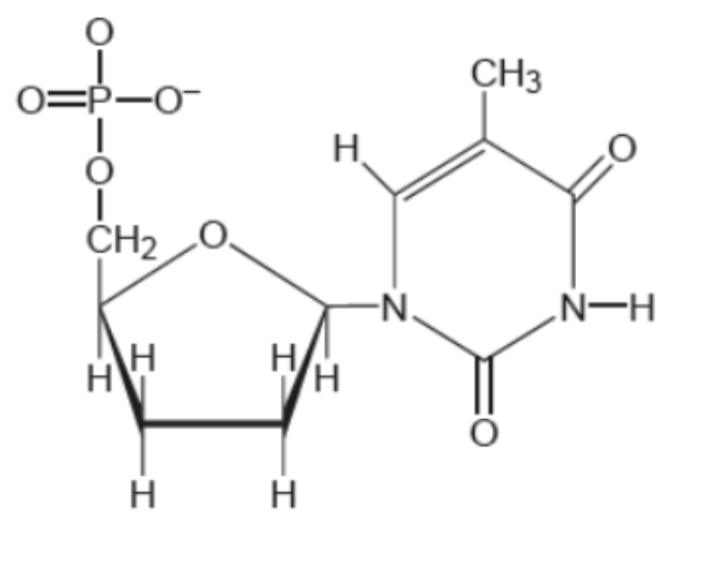
What part of the molecule allows you to distinguish between it and others?
3’, 4’
65
New cards
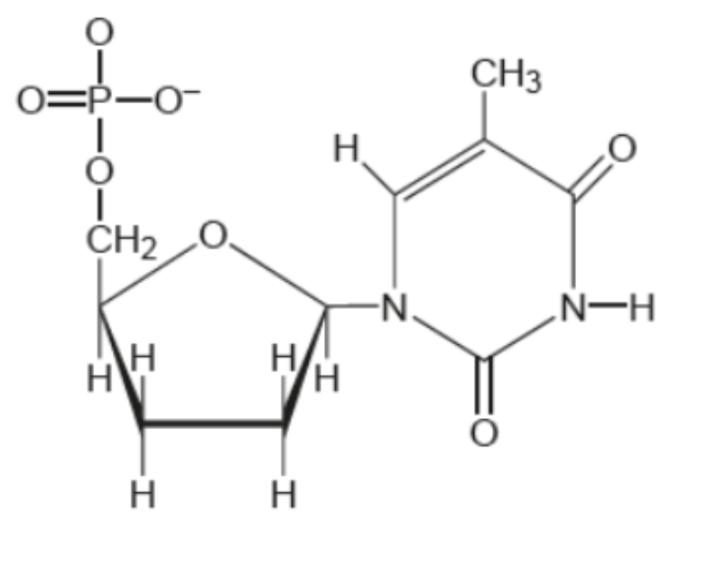
What is the identity of this molecule?
dDNA
66
New cards
What is the reason for using this molecule in base sequencing?
Nucleotides cannot form 5’ to 3’ linkages with these
67
New cards
A strand of mRNA has the following sequence: AUU CUG GCU A.
Which of the following represents the non-transcribed(sense) strand of DNA?
Which of the following represents the non-transcribed(sense) strand of DNA?
ATT CTG GCT A
68
New cards
What does eukaryotic DNA have that is missing from prokaryotic DNA?
Introns
69
New cards
What is the purpose of constructing a karyogram?
To identify abnormal chromosomes in an individual
70
New cards
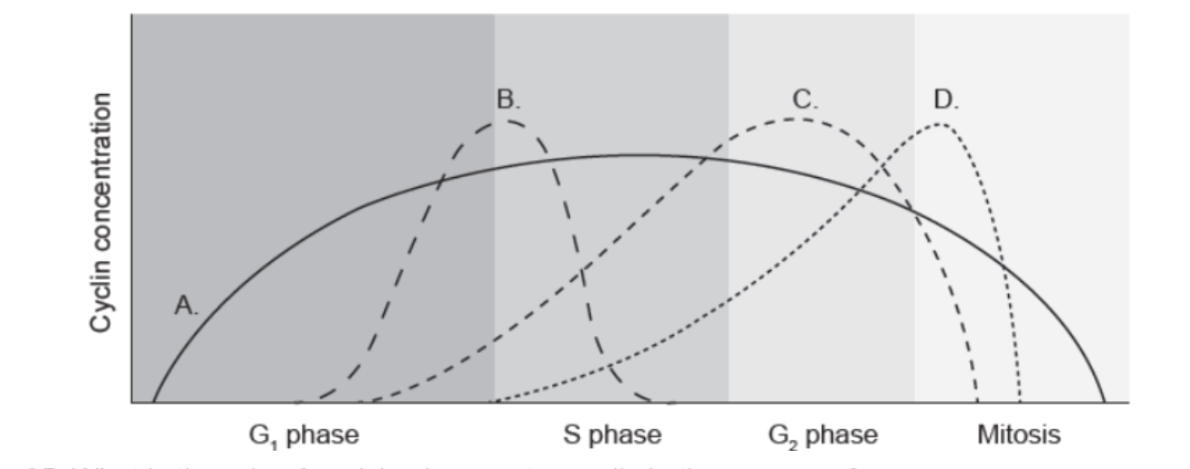
The diagram shows the concentration of 4 cyclins present during the cell cycle.
Which curve represents the cyclin that promotes the assembly of the mitotic spindle?
Which curve represents the cyclin that promotes the assembly of the mitotic spindle?
D
71
New cards
What is the role of vesicles in secretory cells in the pancreas?
To move enzymes out of the cell via exocytosis
72
New cards

What phase of mitosis is cell X in?
Anaphase
73
New cards
A cell contains chloroplasts, plasma membrane and 80S ribosomes. What type of cell could it be?
Plant cell
74
New cards
Chromosome numbers vary between species. Which statement refers to humans?
An egg cell has 22 autosomes.
75
New cards
In the chimpanzee (Pan troglodytes), the diploid number of chromosomes is 48. How many sister chromatids are present in the G2 phase of a somatic cell, such as a cell in the bone marrow of the chimpanzee?
96
76
New cards
What are linked by hydrogen bonds?
Hydrogen and oxygen in different water molecules
77
New cards
Which reaction occurs when a dipeptide is formed from amino acids?
Condensation
78
New cards
A molecule of DNA is found to contain 200 guanine bases, representing 25 % of the total number of bases. How many phosphate groups does this molecule of DNA contain?
800
79
New cards
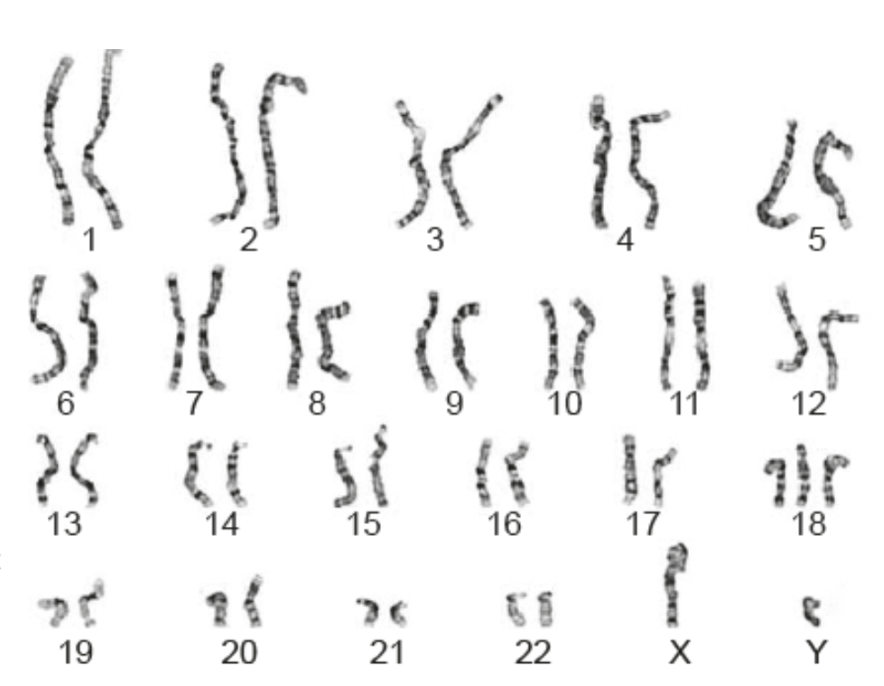
The karyogram shown belongs to a human being. What can be deduced from this karyogram?
The person is a male with a genetic disorder.
80
New cards
Cisplatin is an anti-cancer drug that prevents tumour cells from dividing by mitosis as it inhibits cell processes at stage S of interphase. How does cisplatin prevent cancer cells from dividing?
It inhibits the replication of DNA.
81
New cards
In mammals, mature red blood cells are specialized in that they lack nuclei, mitochondria or ribosomes. Which statement applies to red blood cells?
They cannot produce new enzymes.
82
New cards
The hydrolysis of a pure sample of an organic molecule produces a pentose sugar, thymine, guanine and cytosine. What other substances could be expected to be present in the hydrolysed sample?
Phosphate
83
New cards
Which feature is common to both mRNA and DNA?
Covalent bonds between adjacent nucleotides
84
New cards
Which structures are found only in prokaryotic cells?
Pili
85
New cards
Which processes are involved in the development of cancer?
I. Mutations occur in oncogenes.
II. Oncogenes prevent cancer.
III. Oncogenes affect cell cycle regulatory proteins.
I. Mutations occur in oncogenes.
II. Oncogenes prevent cancer.
III. Oncogenes affect cell cycle regulatory proteins.
I and III only
86
New cards
What is the same in all parts of homologous chromosomes?
Sequence of genes
87
New cards
Some regions of DNA do not code for the production of proteins. What are these regions of DNA used as?
Telomeres and coding for production of tRNA
88
New cards
Which cell component synthesizes actin and myosin?
Free ribosomes
89
New cards
Which types of interactions are found in a part of a protein with secondary but not tertiary structure?
I. Hydrogen bonds
II. Disulphide bridges
III. Ionic bonds
I. Hydrogen bonds
II. Disulphide bridges
III. Ionic bonds
I only
90
New cards
A strand of mRNA consists of the following nucleotides: AUUCUGGCUA
Which of the following represents the non-transcribed (sense) strand of the DNA?
Which of the following represents the non-transcribed (sense) strand of the DNA?
ATTCTGGCTA
91
New cards
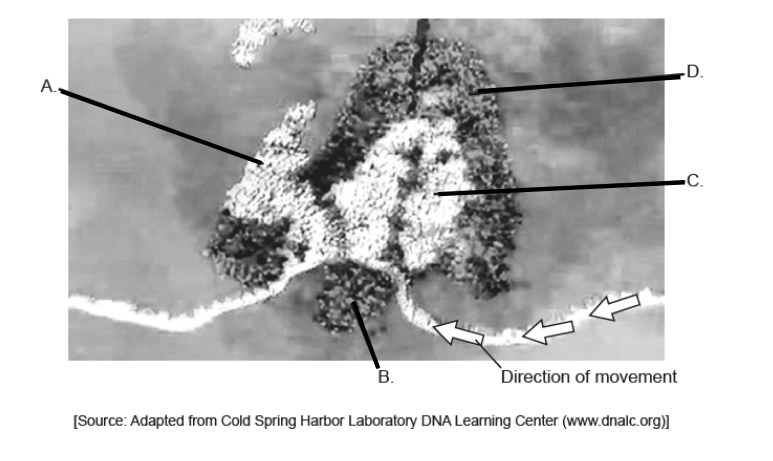
This image is taken from a visualization of a eukaryotic ribosome. The arrows show the direction of movement of mRNA. Which letter represents a tRNA exiting from the E site?
A
92
New cards
In which process(es) do nucleosomes play a role in eukaryotes?
I. tRNA activation
II. Transcription regulation
III. DNA supercoiling
I. tRNA activation
II. Transcription regulation
III. DNA supercoiling
II and III only
93
New cards
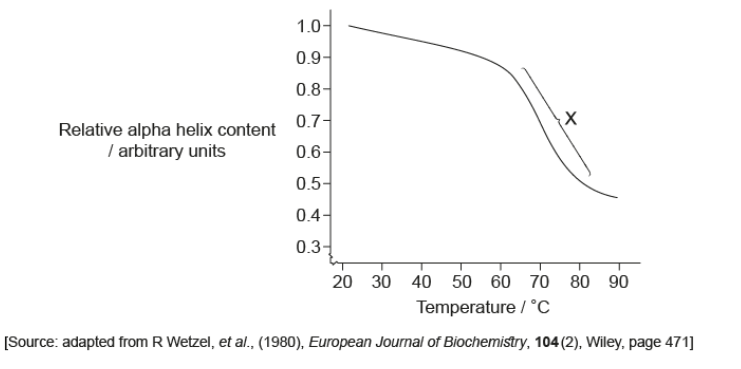
Scientists have heated a solution containing the protein albumin and measured its relative alpha helix content, shown on the graph.
What does the zone labelled X indicate?
What does the zone labelled X indicate?
Rapid increase in denatured protein molecules
94
New cards
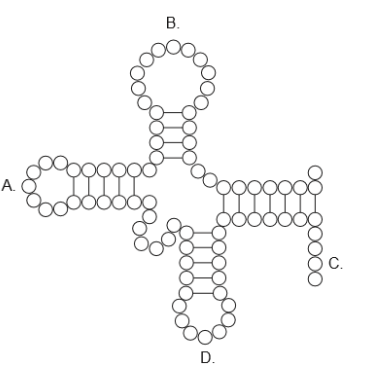
Where does a tRNA-activating enzyme attach the appropriate amino acid to the tRNA molecule?
C
95
New cards
What does post-transcriptional modification of eukaryotic mRNA include?
I. Introns are removed from mRNA.
II. Exons are joined together to form mature mRNA.
III. A 5' cap and 3' poly-A tail are added to mRNA.
I. Introns are removed from mRNA.
II. Exons are joined together to form mature mRNA.
III. A 5' cap and 3' poly-A tail are added to mRNA.
I, II and III
96
New cards
Variations in the types of antibodies are produced by mRNA splicing. What is an advantage of this process?
Increases the number of different antibodies that can be synthesized
97
New cards
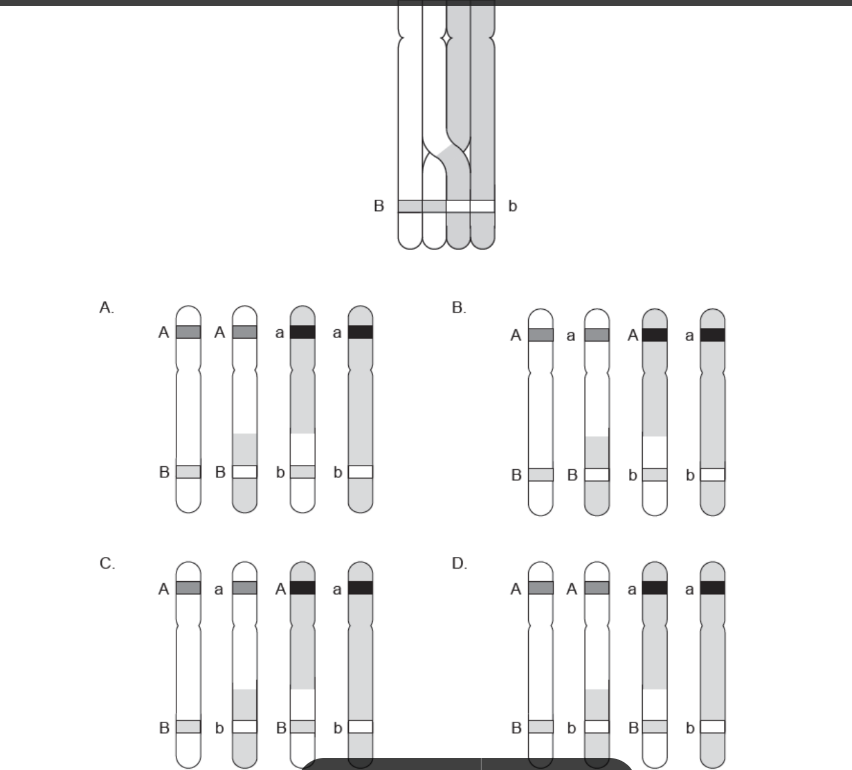
Which gametes can result from the following crossover?
D
98
New cards
The genetic determination of dogs’ coats can be quite complex, with many different genes acting at the same time.
• The dominant allele E gives brown tones. The recessive allele e results in red tones.
• The colour intensity is due to another gene. The dominant allele B gives a dark colour, whereas the recessive allele b results in a light colour.
What would be the genotype of a light brown dog produced from a cross between a dark brown dog and a light red dog?
• The dominant allele E gives brown tones. The recessive allele e results in red tones.
• The colour intensity is due to another gene. The dominant allele B gives a dark colour, whereas the recessive allele b results in a light colour.
What would be the genotype of a light brown dog produced from a cross between a dark brown dog and a light red dog?
Eebb
99
New cards
A couple have four children whose blood groups are A, B and AB. What is the likely combination of the parents’ genotypes?
IAi and IBi
100
New cards
What is produced by meiosis in a cell of a male animal?
Four gametes, each with the same number of chromosomes